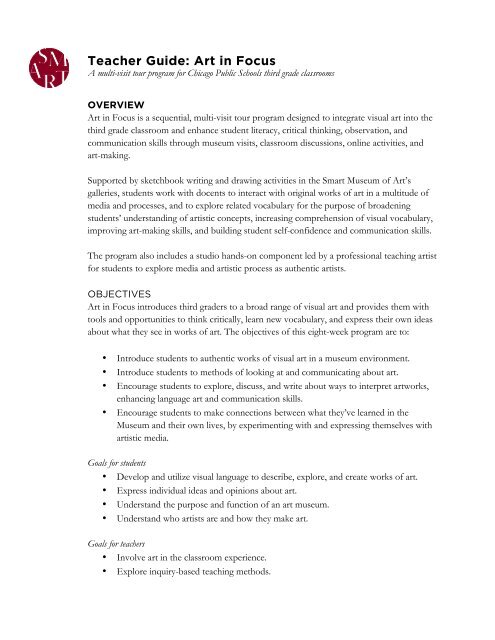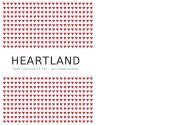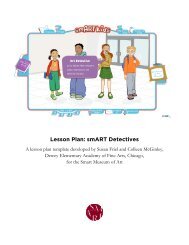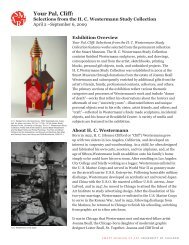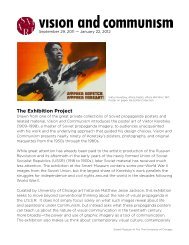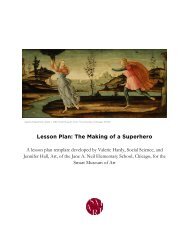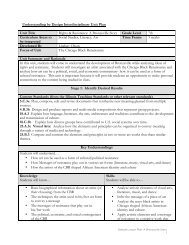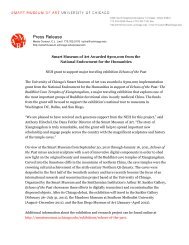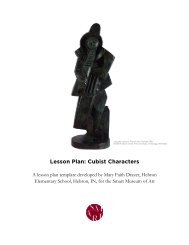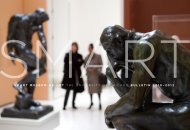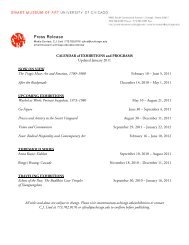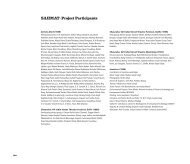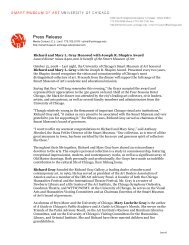Art in Focus teacher guide (PDF) - Smart Museum of Art - University ...
Art in Focus teacher guide (PDF) - Smart Museum of Art - University ...
Art in Focus teacher guide (PDF) - Smart Museum of Art - University ...
Create successful ePaper yourself
Turn your PDF publications into a flip-book with our unique Google optimized e-Paper software.
Teacher Guide: <strong>Art</strong> <strong>in</strong> <strong>Focus</strong><br />
A multi-visit tour program for Chicago Public Schools third grade classrooms<br />
OVERVIEW<br />
<strong>Art</strong> <strong>in</strong> <strong>Focus</strong> is a sequential, multi-visit tour program designed to <strong>in</strong>tegrate visual art <strong>in</strong>to the<br />
third grade classroom and enhance student literacy, critical th<strong>in</strong>k<strong>in</strong>g, observation, and<br />
communication skills through museum visits, classroom discussions, onl<strong>in</strong>e activities, and<br />
art-mak<strong>in</strong>g.<br />
Supported by sketchbook writ<strong>in</strong>g and draw<strong>in</strong>g activities <strong>in</strong> the <strong>Smart</strong> <strong>Museum</strong> <strong>of</strong> <strong>Art</strong>’s<br />
galleries, students work with docents to <strong>in</strong>teract with orig<strong>in</strong>al works <strong>of</strong> art <strong>in</strong> a multitude <strong>of</strong><br />
media and processes, and to explore related vocabulary for the purpose <strong>of</strong> broaden<strong>in</strong>g<br />
students’ understand<strong>in</strong>g <strong>of</strong> artistic concepts, <strong>in</strong>creas<strong>in</strong>g comprehension <strong>of</strong> visual vocabulary,<br />
improv<strong>in</strong>g art-mak<strong>in</strong>g skills, and build<strong>in</strong>g student self-confidence and communication skills.<br />
The program also <strong>in</strong>cludes a studio hands-on component led by a pr<strong>of</strong>essional teach<strong>in</strong>g artist<br />
for students to explore media and artistic process as authentic artists.<br />
OBJECTIVES<br />
<strong>Art</strong> <strong>in</strong> <strong>Focus</strong> <strong>in</strong>troduces third graders to a broad range <strong>of</strong> visual art and provides them with<br />
tools and opportunities to th<strong>in</strong>k critically, learn new vocabulary, and express their own ideas<br />
about what they see <strong>in</strong> works <strong>of</strong> art. The objectives <strong>of</strong> this eight-week program are to:<br />
• Introduce students to authentic works <strong>of</strong> visual art <strong>in</strong> a museum environment.<br />
• Introduce students to methods <strong>of</strong> look<strong>in</strong>g at and communicat<strong>in</strong>g about art.<br />
• Encourage students to explore, discuss, and write about ways to <strong>in</strong>terpret artworks,<br />
enhanc<strong>in</strong>g language art and communication skills.<br />
• Encourage students to make connections between what they’ve learned <strong>in</strong> the<br />
<strong>Museum</strong> and their own lives, by experiment<strong>in</strong>g with and express<strong>in</strong>g themselves with<br />
artistic media.<br />
Goals for students<br />
• Develop and utilize visual language to describe, explore, and create works <strong>of</strong> art.<br />
• Express <strong>in</strong>dividual ideas and op<strong>in</strong>ions about art.<br />
• Understand the purpose and function <strong>of</strong> an art museum.<br />
• Understand who artists are and how they make art.<br />
Goals for <strong>teacher</strong>s<br />
• Involve art <strong>in</strong> the classroom experience.<br />
• Explore <strong>in</strong>quiry-based teach<strong>in</strong>g methods.
• Integrate website technology <strong>in</strong>to the curriculum.<br />
CURRICULAR CONNECTIONS<br />
The <strong>Smart</strong>’s <strong>Art</strong> <strong>in</strong> <strong>Focus</strong> multi-visit program meets Ill<strong>in</strong>ois State Standards and the<br />
Common Core curriculum <strong>in</strong> the areas <strong>of</strong> English Language <strong>Art</strong>s, F<strong>in</strong>e <strong>Art</strong>s, Social Science,<br />
Math, and Social/Emotional Learn<strong>in</strong>g.<br />
Students read images as <strong>in</strong>formational text, use techniques like compare and contrast to<br />
discuss works <strong>of</strong> art, give evidence to support <strong>in</strong>ferences and op<strong>in</strong>ions, make direct and<br />
personal connections to authentic works <strong>of</strong> art, and consider multiple perspectives <strong>in</strong><br />
discussions.<br />
PROGRAM STRUCTURE<br />
<strong>Art</strong> <strong>in</strong> <strong>Focus</strong> consists <strong>of</strong> four field trips to the <strong>Smart</strong> <strong>Museum</strong> <strong>of</strong> <strong>Art</strong>, each paired with a<br />
studio activity to take place the follow<strong>in</strong>g week <strong>in</strong> the classroom, led by a pr<strong>of</strong>essional<br />
teach<strong>in</strong>g artist. There are four museum visits and four studio sessions <strong>in</strong> a complete<br />
sequence. Except<strong>in</strong>g holiday conflicts, the eight sessions take place over consecutive weeks,<br />
ideally always scheduled for the same weekday and time.<br />
<strong>Museum</strong> visits and studio sessions are 90 m<strong>in</strong>utes <strong>in</strong> length. Pre- and post-visit classroom<br />
activities should be planned <strong>in</strong> accordance with this schedule.<br />
<strong>Museum</strong> Visits<br />
Specially tra<strong>in</strong>ed <strong>University</strong> <strong>of</strong> Chicago student docents lead all <strong>Museum</strong> visits (each 90<br />
m<strong>in</strong>utes) and <strong>in</strong>troduce students to methods <strong>of</strong> look<strong>in</strong>g at and communicat<strong>in</strong>g about works<br />
<strong>of</strong> visual art.<br />
Supported by writ<strong>in</strong>g and draw<strong>in</strong>g activities <strong>in</strong> the <strong>Museum</strong> galleries, students work with<br />
docents to develop a visual vocabulary that allows them to explore their own ideas about art;<br />
<strong>in</strong>creases critical th<strong>in</strong>k<strong>in</strong>g and communication skills; builds a comprehension <strong>of</strong> the tools and<br />
processes <strong>of</strong> creation, as well as the purpose and function <strong>of</strong> museums. Each classroom<br />
works with the same docents for all museum sessions; this is one <strong>of</strong> the ways <strong>in</strong> which<br />
cont<strong>in</strong>uity and rapport is built <strong>in</strong>to the programs.<br />
Studio Sessions<br />
<strong>Art</strong> <strong>in</strong> <strong>Focus</strong> <strong>in</strong>cludes four <strong>Museum</strong> visits alternat<strong>in</strong>g with four art-mak<strong>in</strong>g sessions led by a<br />
pr<strong>of</strong>essional teach<strong>in</strong>g artist <strong>in</strong> the students’ own classrooms. Dur<strong>in</strong>g the <strong>in</strong>-classroom studio<br />
sessions, Joel Javier—a Chicago-based artist with extensive teach<strong>in</strong>g experience—<strong>in</strong>troduces<br />
the students to a wide range <strong>of</strong> processes and media <strong>in</strong> order to re<strong>in</strong>force concepts covered<br />
dur<strong>in</strong>g the <strong>Museum</strong> visits and encourage students <strong>in</strong> their own work. The students create<br />
artworks <strong>in</strong>spired by the <strong>Museum</strong> collection.<br />
<strong>Smart</strong> <strong>Museum</strong> <strong>of</strong> <strong>Art</strong>, The <strong>University</strong> <strong>of</strong> Chicago<br />
<strong>Art</strong> <strong>in</strong> <strong>Focus</strong> Teacher Guide, page 2
PROGRAM OUTLINE<br />
The outl<strong>in</strong>e and objectives for each week <strong>of</strong> the <strong>Art</strong> <strong>in</strong> <strong>Focus</strong> program are detailed below.<br />
Week 1<br />
<strong>Smart</strong> <strong>Museum</strong> visit: Elements <strong>of</strong> <strong>Art</strong><br />
Students will be <strong>in</strong>troduced to the basic elements <strong>of</strong> art (l<strong>in</strong>e, shape, color, texture). Together<br />
the group will consider how these elements come together, <strong>in</strong> both representational and<br />
abstract works, to create a composition.<br />
Week 2<br />
Studio Session: Abstract Portrait<br />
<strong>Smart</strong> <strong>Museum</strong> art connection: Soldier at a Game <strong>of</strong> Chess by Jean Metz<strong>in</strong>ger<br />
Students will look at an art historic source image (portrait) and create an abstract version<br />
us<strong>in</strong>g elements <strong>of</strong> art, contrast<strong>in</strong>g colors, textures & shapes <strong>in</strong> the medium <strong>of</strong> collage.<br />
Week 3<br />
<strong>Smart</strong> <strong>Museum</strong> visit: Content and Creation<br />
Students will cont<strong>in</strong>ue to explore the elements <strong>of</strong> art as they relate to two-dimensional<br />
objects representative <strong>of</strong> a variety <strong>of</strong> media (e.g., pr<strong>in</strong>ts, photography, pa<strong>in</strong>t<strong>in</strong>gs). This will<br />
<strong>in</strong>clude a discussion <strong>of</strong> design as art <strong>in</strong> functional objects.<br />
Week 4<br />
Studio Session: Hybrid Objects<br />
<strong>Smart</strong> <strong>Museum</strong> art connection: Translated Vase by Yeesookyung<br />
Students th<strong>in</strong>k about the functional art pieces they saw at the museum and consider how the<br />
elements <strong>of</strong> art were used to design them. Students design their own object.<br />
Week 5<br />
<strong>Smart</strong> <strong>Museum</strong> visit: Stories <strong>in</strong> <strong>Art</strong><br />
Look<strong>in</strong>g at narratives, or stories, will <strong>in</strong>troduce students to the idea <strong>of</strong> communication <strong>in</strong> art.<br />
Students will practice <strong>in</strong>terpret<strong>in</strong>g what stories they see <strong>in</strong> works <strong>of</strong> art (imag<strong>in</strong><strong>in</strong>g what<br />
happens next), will support their ideas with evidence, and should consider multiple<br />
<strong>in</strong>terpretations. Students will look for details to consider how they relate to the subject <strong>of</strong> the<br />
composition.<br />
Week 6<br />
Studio Session: City Sketches<br />
<strong>Smart</strong> <strong>Museum</strong> art connection: The City by Alice Neel<br />
Students will create a landscape or cityscape draw<strong>in</strong>g that tells a story and communicates a<br />
mood.<br />
<strong>Smart</strong> <strong>Museum</strong> <strong>of</strong> <strong>Art</strong>, The <strong>University</strong> <strong>of</strong> Chicago<br />
<strong>Art</strong> <strong>in</strong> <strong>Focus</strong> Teacher Guide, page 3
Week 7<br />
<strong>Smart</strong> <strong>Museum</strong> visit: Th<strong>in</strong>k About <strong>Art</strong><br />
Students will use their visual vocabulary to synthesize and express their ideas about works <strong>of</strong><br />
art (<strong>in</strong> writ<strong>in</strong>g, through sketch<strong>in</strong>g, photography, and oral communication) to share personal<br />
op<strong>in</strong>ions, support their ideas us<strong>in</strong>g visual evidence, listen to other po<strong>in</strong>ts <strong>of</strong> view, and respect<br />
differ<strong>in</strong>g op<strong>in</strong>ions.<br />
Week 8<br />
Studio Session: Mak<strong>in</strong>g a <strong>Smart</strong> Connection<br />
<strong>Smart</strong> <strong>Museum</strong> art connection: student’s choice<br />
Students will create a work <strong>in</strong>spired by a piece they have seen <strong>in</strong> the <strong>Smart</strong> <strong>Museum</strong>.<br />
ASSESSMENT<br />
In addition to feedback from our docents and <strong>teacher</strong>s, we also have <strong>in</strong> place an evolv<strong>in</strong>g,<br />
responsive system <strong>of</strong> evaluation that has been critical to the ongo<strong>in</strong>g success <strong>of</strong> the multivisit<br />
tour programs. In 2012-2013, this system will be three-fold:<br />
1) Pre- and post-student writ<strong>in</strong>g assessments<br />
2) Pre- and post-<strong>teacher</strong> surveys<br />
3) Evaluations executed by graduate students at the <strong>University</strong> <strong>of</strong> Chicago<br />
The pre- and post-writ<strong>in</strong>g assessments are writ<strong>in</strong>g activities distributed by docents at the<br />
start <strong>of</strong> the first <strong>Smart</strong> <strong>Museum</strong> visit and aga<strong>in</strong> at the last visit. Students have ten m<strong>in</strong>utes to<br />
describe an artwork pr<strong>in</strong>ted on their handout (the same artwork is used for both pre- and<br />
post-assessments).<br />
The <strong>teacher</strong>s’ pre-surveys document teach<strong>in</strong>g experience, level <strong>of</strong> comfort <strong>in</strong>tegrat<strong>in</strong>g the<br />
arts <strong>in</strong> the curriculum, and expectations for apply<strong>in</strong>g tour concepts <strong>in</strong> the classroom. The<br />
post-surveys ask <strong>teacher</strong>s to rate the complete tour experience, comment on docent delivery,<br />
expla<strong>in</strong> how the program <strong>in</strong>formed or complemented their teach<strong>in</strong>g, and reflect on<br />
challenges and benefits to implement<strong>in</strong>g the program. The surveys also solicit suggestions<br />
for future pr<strong>of</strong>essional development <strong>of</strong>fer<strong>in</strong>gs at the <strong>Museum</strong>.<br />
All participat<strong>in</strong>g classes will also have two graduate Student Program Assistants (SPA) from<br />
the <strong>University</strong> assigned to observe, document, and report any challenges or successes<br />
follow<strong>in</strong>g each visit. Because the SPA team will observe both <strong>Smart</strong> <strong>Museum</strong> visits and <strong>in</strong><br />
class art-mak<strong>in</strong>g sessions <strong>in</strong> addition to analyz<strong>in</strong>g the students’ sketchbook activities, they are<br />
<strong>in</strong> a unique position to facilitate communication between docents, <strong>teacher</strong>s, the teach<strong>in</strong>g<br />
artist, and <strong>Museum</strong> education staff—which will allow the docents and teach<strong>in</strong>g artist to<br />
make timely changes as needed.<br />
<strong>Smart</strong> <strong>Museum</strong> <strong>of</strong> <strong>Art</strong>, The <strong>University</strong> <strong>of</strong> Chicago<br />
<strong>Art</strong> <strong>in</strong> <strong>Focus</strong> Teacher Guide, page 4
PARTNERSHIP<br />
Integrat<strong>in</strong>g all facets <strong>of</strong> the visual arts <strong>in</strong>to the school curriculum enables the <strong>Smart</strong> to<br />
ma<strong>in</strong>ta<strong>in</strong> long-term partnerships with Chicago Public Schools <strong>in</strong> neighborhoods<br />
surround<strong>in</strong>g the <strong>University</strong> <strong>of</strong> Chicago on the city’s South Side.<br />
As part <strong>of</strong> the <strong>Art</strong> <strong>in</strong> <strong>Focus</strong> program, participat<strong>in</strong>g <strong>teacher</strong>s receive an extensive, week-byweek<br />
curriculum that outl<strong>in</strong>es the objectives for each visit—<strong>in</strong>clud<strong>in</strong>g related vocabulary and<br />
concepts that the docents will address—and hands-on lesson ideas that <strong>in</strong>tegrate objects<br />
from the <strong>Museum</strong> collection and a supplementary kit <strong>of</strong> art supplies. Each <strong>teacher</strong> attends a<br />
pr<strong>of</strong>essional development workshop (held quarterly) as an orientation before their classroom<br />
tours beg<strong>in</strong> and to ma<strong>in</strong>ta<strong>in</strong> the network <strong>of</strong> participat<strong>in</strong>g <strong>teacher</strong>s. Dur<strong>in</strong>g the workshop<br />
<strong>teacher</strong>s review the curriculum with museum staff, participate <strong>in</strong> hands-on art-mak<strong>in</strong>g with<br />
the Teach<strong>in</strong>g <strong>Art</strong>ist, and work together to draft arts-<strong>in</strong>tegrated lesson plans.<br />
What does the <strong>Smart</strong> <strong>Museum</strong> provide?<br />
This program is a partnership between the <strong>Smart</strong> <strong>Museum</strong> and <strong>teacher</strong>s. In addition to<br />
ongo<strong>in</strong>g communication and logistical management, the <strong>Museum</strong> <strong>of</strong>fers:<br />
• Four docent-led museum visits<br />
• Four teach<strong>in</strong>g artist-led art studio visits<br />
• Bus transportation<br />
• Teacher tra<strong>in</strong><strong>in</strong>g<br />
• <strong>Art</strong>-mak<strong>in</strong>g supplies<br />
• Suggested classroom activities<br />
• Acknowledgement to students at the end <strong>of</strong> the program<br />
• Program assessment and documentation<br />
What are the <strong>teacher</strong>’s responsibilities?<br />
In partnership with the <strong>Smart</strong> <strong>Museum</strong>, <strong>teacher</strong>s are expected to:<br />
• Attend <strong>teacher</strong> tra<strong>in</strong><strong>in</strong>g <strong>in</strong> advance <strong>of</strong> the program<br />
• Collaborate with Student Program Assistants to create one artist-<strong>in</strong>tegrated lesson<br />
plan to be co-taught dur<strong>in</strong>g the year<br />
• Ma<strong>in</strong>ta<strong>in</strong> regular communication with <strong>Museum</strong> staff dur<strong>in</strong>g the school year<br />
• Prepare students for each <strong>Museum</strong> visit<br />
• Assist the Teach<strong>in</strong>g <strong>Art</strong>ist and Student Program Assistants dur<strong>in</strong>g the studio sessions<br />
Participat<strong>in</strong>g <strong>teacher</strong>s also collaborate with the Student Program Assistants to develop their<br />
own unique, arts-<strong>in</strong>tegrated lesson for <strong>in</strong>corporation <strong>in</strong>to their curriculum. Lesson<br />
development should be coord<strong>in</strong>ated between <strong>teacher</strong>s and SPAs and can take place any time<br />
<strong>Smart</strong> <strong>Museum</strong> <strong>of</strong> <strong>Art</strong>, The <strong>University</strong> <strong>of</strong> Chicago<br />
<strong>Art</strong> <strong>in</strong> <strong>Focus</strong> Teacher Guide, page 5
dur<strong>in</strong>g the duration <strong>of</strong> the eight-week program. This facet <strong>of</strong> the program can take place any<br />
time dur<strong>in</strong>g the duration <strong>of</strong> the eight-week program and is <strong>in</strong>tended to accomplish two goals:<br />
(1) to give aspir<strong>in</strong>g <strong>teacher</strong>s the opportunity to work with master educators and (2) to<br />
support veteran <strong>teacher</strong>s <strong>in</strong> creat<strong>in</strong>g new lessons that make use <strong>of</strong> the collection. Lessons<br />
should be co-taught and can take place dur<strong>in</strong>g the eight-week program or <strong>in</strong> the month<br />
follow<strong>in</strong>g.<br />
IN THE CLASSROOM<br />
<strong>Art</strong> can be an <strong>in</strong>tegral part <strong>of</strong> the classroom rout<strong>in</strong>e. The <strong>Smart</strong> <strong>Museum</strong> education<br />
department is committed to arts <strong>in</strong>tegration <strong>in</strong> K–12 classrooms. You are welcome to call<br />
Lisa Davis, <strong>Smart</strong> <strong>Museum</strong> Manager <strong>of</strong> Tour and Teacher Initiatives, at 773.834.1066 for<br />
year-round for assistance <strong>in</strong> add<strong>in</strong>g or expand<strong>in</strong>g the role <strong>of</strong> visual art <strong>in</strong> your classroom.<br />
SMARTKIDS WEBSITE<br />
The <strong>Museum</strong>’s smARTkids website (smartmuseum.uchicago.edu/smartkids) is a valuable<br />
resource for kid-friendly art concepts, activities, and resources. With<strong>in</strong> this <strong>teacher</strong>’s <strong>guide</strong><br />
you will f<strong>in</strong>d suggested lesson ideas from the website that may be implemented with<strong>in</strong> or<br />
outside <strong>of</strong> the four-week program timeframe, at the art or classroom <strong>teacher</strong>’s discretion.<br />
These art, writ<strong>in</strong>g, and technology-based activities allow for the skills fostered <strong>in</strong> <strong>Art</strong> <strong>in</strong><br />
<strong>Focus</strong> to grow throughout the school year. Careful consideration has been given to the<br />
amount <strong>of</strong> classroom time required for any given activity.<br />
In particular, the <strong>Art</strong>work <strong>of</strong> the Month component (copies <strong>of</strong> which can also be found <strong>in</strong><br />
the red folder <strong>of</strong> your kit) provides art activities based on objects <strong>in</strong> the <strong>Smart</strong> <strong>Museum</strong><br />
collection and developed specifically for elementary school-aged children. These activities<br />
are well-suited for non-art classrooms or to try at home, and utilize supplies from the<br />
classroom kit and materials commonly found around the house. The n<strong>in</strong>e hands-on art<br />
activities are great to use at any po<strong>in</strong>t <strong>in</strong> the school year. Try them all!<br />
CLASSROOM KIT<br />
The classroom kit conta<strong>in</strong>s a mixture <strong>of</strong> art supplies, such as scissors, glue, Cray-Pas oil<br />
pastels, decorative paper, and other materials appropriate for classroom use.<br />
BEFORE YOU VISIT<br />
These are important po<strong>in</strong>ts to consider before your classroom’s first visit to the <strong>Smart</strong>:<br />
Prepar<strong>in</strong>g Your Students<br />
Have any <strong>of</strong> your students been to a museum before? What about an art museum? What did<br />
they do there? How did they feel about their experience? If they have never been to an art<br />
museum, what do they th<strong>in</strong>k it will be like?<br />
<strong>Smart</strong> <strong>Museum</strong> <strong>of</strong> <strong>Art</strong>, The <strong>University</strong> <strong>of</strong> Chicago<br />
<strong>Art</strong> <strong>in</strong> <strong>Focus</strong> Teacher Guide, page 6
One <strong>of</strong> the goals <strong>of</strong> the <strong>Smart</strong> <strong>Museum</strong>’s <strong>Art</strong> <strong>in</strong> <strong>Focus</strong> program is to <strong>in</strong>crease student<br />
awareness <strong>of</strong> the purpose and function <strong>of</strong> an art museum. Through repeat visits to the <strong>Smart</strong><br />
<strong>Museum</strong>, it is hoped that students feel a sense <strong>of</strong> ownership <strong>of</strong> the <strong>Museum</strong> and its<br />
collection, and come to realize that the <strong>Smart</strong> and other cultural <strong>in</strong>stitutions <strong>of</strong>fer a variety <strong>of</strong><br />
rich experiences to them both <strong>in</strong> and out <strong>of</strong> school.<br />
You can help get th<strong>in</strong>gs started on the right track by discuss<strong>in</strong>g the <strong>Smart</strong> <strong>Museum</strong> with your<br />
class <strong>in</strong> advance <strong>of</strong> the first visit. Describe the program to them. Ask them to share their<br />
thoughts on what the experience might be like. What questions do they have about art<br />
museums, and about the <strong>Smart</strong> <strong>in</strong> particular? See the <strong>Smart</strong> <strong>Museum</strong> FAQ below to help<br />
facilitate the conversation.<br />
Although the docents will talk about museum rules at each visit, it is wise to <strong>in</strong>troduce these<br />
rules before the first visit. See Visitor Policies below for <strong>in</strong>formation on <strong>Smart</strong> <strong>Museum</strong><br />
rules and etiquette. What rules can your students come up with without prompt<strong>in</strong>g? Which<br />
rules need further discussion <strong>in</strong>to their purpose (i.e., prohibitions aga<strong>in</strong>st touch<strong>in</strong>g art and<br />
writ<strong>in</strong>g with pens)?<br />
The benefits <strong>of</strong> pre-visit preparation will be apparent right from the start, and will ensure an<br />
improved field trip experience for everyone.<br />
CHAPERONES<br />
Chaperones play an important role at each <strong>Smart</strong> <strong>Museum</strong> visit. Even though a docent will<br />
be with your students at all times, this is not sufficient adult supervision.<br />
While there is no limit to the number <strong>of</strong> chaperones that accompany your class, we ask that<br />
at least two accompany your class at the <strong>Smart</strong> <strong>Museum</strong> each visit. Your class will be divided<br />
<strong>in</strong>to two groups. If at least one chaperone follows each group, then you are free to float<br />
between the two groups and assist with discipl<strong>in</strong>e as needed.<br />
VISITOR POLICIES<br />
Do not touch! F<strong>in</strong>gers, pen po<strong>in</strong>ts, pencils, and paper edges can easily scratch the surface <strong>of</strong><br />
artworks. Please don’t touch and, to avoid accidents, always stay at least one foot away from<br />
artworks and cases. <strong>Museum</strong> gallery attendants might rem<strong>in</strong>d you to keep this distance.<br />
Be aware <strong>of</strong> where you are <strong>in</strong> relation to the artworks. The <strong>Smart</strong> <strong>Museum</strong> galleries are<br />
relatively small. Please be aware <strong>of</strong> artworks and cases that are near or beh<strong>in</strong>d you. Rem<strong>in</strong>d<br />
young people that runn<strong>in</strong>g and physical play are not allowed <strong>in</strong> the <strong>Museum</strong>.<br />
Do not lean or sit on display cases or low pedestals. These are used to protect artworks.<br />
Please do not write or place objects on them.<br />
<strong>Smart</strong> <strong>Museum</strong> <strong>of</strong> <strong>Art</strong>, The <strong>University</strong> <strong>of</strong> Chicago<br />
<strong>Art</strong> <strong>in</strong> <strong>Focus</strong> Teacher Guide, page 7
Use only pencils <strong>in</strong> the galleries. Docents provide pencils for sketchbook activities.<br />
NO food or dr<strong>in</strong>k permitted <strong>in</strong> the exhibition space.<br />
Visitors may not br<strong>in</strong>g umbrellas or large bags <strong>in</strong>to the gallery space. The size <strong>guide</strong><br />
for acceptable bags is an 8.5 x 11 <strong>in</strong>ch manila envelope. Any bags larger than this standard<br />
must be checked. Strollers are permitted.<br />
Your students will review this abbreviated version <strong>of</strong> the rules at the start <strong>of</strong> each tour:<br />
Don’t touch art or walls.<br />
Raise hands to talk.<br />
Always look and listen.<br />
Write <strong>in</strong> pencil only.<br />
THE DAY OF TOUR<br />
Remember to br<strong>in</strong>g student nametags and sketchbooks to every <strong>Smart</strong> <strong>Museum</strong> visit. A note<br />
about nametags: please pr<strong>in</strong>t (or ask students to pr<strong>in</strong>t) names <strong>in</strong> large type <strong>in</strong> pen or marker.<br />
The docents rely on clearly legible nametags to better communicate with your students.<br />
The bus drops <strong>of</strong>f and picks up students from the same po<strong>in</strong>t at the <strong>Museum</strong>: on 55th and<br />
Greenwood at the entrance to the <strong>Museum</strong> courtyard. Docents will greet your class <strong>in</strong> the<br />
<strong>Smart</strong> <strong>Museum</strong> lobby, and direct students to the coatroom and washrooms as necessary.<br />
The tour beg<strong>in</strong>s with a docent-led <strong>in</strong>troduction <strong>in</strong> the galleries for the entire class. Near the<br />
end <strong>of</strong> the <strong>in</strong>troduction, you will be asked to distribute the sketchbooks if you have not done<br />
so already. The docents will ask you at the end <strong>of</strong> the fifteen-m<strong>in</strong>ute <strong>in</strong>troduction to divide<br />
your students <strong>in</strong>to two groups. It is recommended that you determ<strong>in</strong>e the roster <strong>of</strong> each group prior to<br />
this po<strong>in</strong>t. Please be sure that chaperones are aware <strong>of</strong> which group they are to travel with.<br />
Each docent takes one group and departs on the rema<strong>in</strong>der <strong>of</strong> the tour.<br />
You will notice that docents use an <strong>in</strong>quiry-based method <strong>of</strong> discussion <strong>in</strong> the galleries.<br />
Students respond to open-ended questions about art, and are asked to provide visual<br />
evidence for their responses. All students are encouraged to be active participants and<br />
supportive listeners. Sometimes, <strong>in</strong> the excitement <strong>of</strong> the experience, students forget to raise<br />
hands and take turns speak<strong>in</strong>g. If you have a special signal to quickly re-focus your students<br />
(count<strong>in</strong>g, handclaps, etc.), please share it with your docents. They will appreciate this tip!<br />
<strong>Smart</strong> <strong>Museum</strong> <strong>of</strong> <strong>Art</strong>, The <strong>University</strong> <strong>of</strong> Chicago<br />
<strong>Art</strong> <strong>in</strong> <strong>Focus</strong> Teacher Guide, page 8
If, after observ<strong>in</strong>g <strong>in</strong>quiry-based discussion <strong>in</strong> the galleries, you would like to learn more<br />
about <strong>in</strong>quiry applications <strong>in</strong> the classroom (across the curriculum, not just <strong>in</strong> the arts),<br />
please contact the <strong>Smart</strong> education department for additional <strong>in</strong>formation.<br />
FREQUENTLY ASKED QUESTIONS<br />
Dur<strong>in</strong>g your classroom’s participation <strong>in</strong> this program, your students will likely have<br />
questions about the <strong>Smart</strong>, or about art museums <strong>in</strong> general. This FAQ was created to<br />
answer many <strong>of</strong> those questions.<br />
ART MUSEUM QUESTIONS<br />
Q: What is a museum?<br />
A: A museum is a place dedicated to collect<strong>in</strong>g, car<strong>in</strong>g for, study<strong>in</strong>g, and display<strong>in</strong>g objects.<br />
In our case, we are an art museum, so we collect art objects (more commonly known as<br />
artworks) and display them <strong>in</strong> galleries.<br />
Q: What is a gallery?<br />
A: Sometimes we use the word gallery for places that sell artwork. However, with<strong>in</strong> a<br />
museum, a gallery is a room <strong>in</strong> which artworks are on display. A museum usually has more<br />
than one gallery. In our case, we have seven galleries.<br />
Q: Who decides which artworks are displayed at an art museum?<br />
A: Curators do. Curators are members <strong>of</strong> the museum staff. Their job is to care for the<br />
collections, research the objects, and decide which artworks will go on view and how they<br />
should be arranged <strong>in</strong> the galleries. Sometimes curators make a special presentation <strong>of</strong><br />
objects called an exhibition.<br />
Q: What is an exhibition?<br />
A: An exhibition is a presentation <strong>of</strong> objects. The objects <strong>in</strong> an exhibition connect to one<br />
another <strong>in</strong> a particular way, such as appearance, function, technique, time period, or subject<br />
matter. Usually exhibitions are only displayed for a limited period <strong>of</strong> time. At the <strong>Smart</strong><br />
<strong>Museum</strong>, some exhibitions are on display for as little as two months, while others are much<br />
longer.<br />
Q: Who are docents?<br />
A: Docents (dōh-sents) specialize <strong>in</strong> help<strong>in</strong>g museum visitors look and talk about art. They<br />
lead tours <strong>of</strong> museums, po<strong>in</strong>t<strong>in</strong>g out and discuss<strong>in</strong>g certa<strong>in</strong> artworks.<br />
Q: Why can’t we touch the art?<br />
A: All <strong>of</strong> us have oils <strong>in</strong> our sk<strong>in</strong> that <strong>in</strong>teract with the chemicals <strong>in</strong> the artworks when we<br />
touch them. After repeated touches, the artworks will show signs <strong>of</strong> wear. We don’t let<br />
anyone touch the works <strong>of</strong> art because we want the artworks to rema<strong>in</strong> look<strong>in</strong>g the way they<br />
<strong>Smart</strong> <strong>Museum</strong> <strong>of</strong> <strong>Art</strong>, The <strong>University</strong> <strong>of</strong> Chicago<br />
<strong>Art</strong> <strong>in</strong> <strong>Focus</strong> Teacher Guide, page 9
do now, so that future visitors can appreciate them as much as you will. Some works are very<br />
fragile. It’s possible that by touch<strong>in</strong>g a work <strong>of</strong> art, you may accidentally break someth<strong>in</strong>g <strong>of</strong>f<br />
<strong>of</strong> it or scratch it. Even museum staff members have to be careful with artworks. To move<br />
artworks, our staff members wear special gloves.<br />
SMART MUSEUM QUESTIONS<br />
Q: Why is it called the <strong>Smart</strong> <strong>Museum</strong>?<br />
A: The <strong>Museum</strong> is named after two brothers, David and Alfred <strong>Smart</strong>, who were <strong>in</strong>terested<br />
<strong>in</strong> art and education. David and Alfred <strong>Smart</strong> founded Esquire, Incorporated <strong>in</strong> 1931 and<br />
were the publishers <strong>of</strong> Esquire magaz<strong>in</strong>e. After they died, the <strong>Smart</strong> Family Foundation gave<br />
the <strong>University</strong> <strong>of</strong> Chicago a donation to establish a f<strong>in</strong>e arts gallery. The David and Alfred<br />
<strong>Smart</strong> <strong>Museum</strong> opened <strong>in</strong> 1974.<br />
Q: What k<strong>in</strong>d <strong>of</strong> art do you have?<br />
A: Our collection <strong>in</strong>cludes artworks from ancient times to the present, <strong>in</strong>clud<strong>in</strong>g pa<strong>in</strong>t<strong>in</strong>gs,<br />
sculptures, furniture, pottery, Asian scrolls, pr<strong>in</strong>ts, draw<strong>in</strong>gs, and photographs. We have a<br />
number <strong>of</strong> works by Chicago artists.<br />
Q: Do you have any famous artworks?<br />
A: We don’t have anyth<strong>in</strong>g as famous as the Mona Lisa, but we do have some works by<br />
famous artists such as Mark Rothko and Frank Lloyd Wright. We also have many terrific<br />
artworks by lesser-known artists from the United States, Europe, Asia, and Lat<strong>in</strong> America.<br />
Q: How big is the collection?<br />
A: We have over 12,000 artworks!<br />
Q: Is the whole collection on view?<br />
A: No. Our build<strong>in</strong>g is not large enough to show the whole collection. Selections from our<br />
collection are displayed, and these selections are <strong>of</strong>ten changed to allow people to see<br />
different artworks. Usually a couple hundred works are on display. The rest are carefully put<br />
away <strong>in</strong> storage rooms.<br />
Q: Where does the art come from?<br />
A: Our artworks come to us <strong>in</strong> many ways. Many objects first belonged to other departments<br />
on campus before they were given to the <strong>Smart</strong>. Sometimes people who have gone to school<br />
at the <strong>University</strong> <strong>of</strong> Chicago or who collect art donate artworks to the <strong>Smart</strong> <strong>Museum</strong>. The<br />
<strong>Museum</strong> also purchases artworks each year from artists and art dealers. F<strong>in</strong>ally, some <strong>of</strong> the<br />
artworks you will see <strong>in</strong> the <strong>Museum</strong> are either on loan from <strong>in</strong>dividual collectors, or are part<br />
<strong>of</strong> travel<strong>in</strong>g exhibitions organized by other museums and galleries.<br />
<strong>Smart</strong> <strong>Museum</strong> <strong>of</strong> <strong>Art</strong>, The <strong>University</strong> <strong>of</strong> Chicago<br />
<strong>Art</strong> <strong>in</strong> <strong>Focus</strong> Teacher Guide, page 10
Q: Why are you on a university campus?<br />
A: The <strong>University</strong> <strong>of</strong> Chicago has collected art objects s<strong>in</strong>ce its found<strong>in</strong>g <strong>in</strong> 1892 to use as<br />
teach<strong>in</strong>g tools. Before the <strong>Smart</strong> <strong>Museum</strong> opened, these objects were scattered across<br />
campus <strong>in</strong> various departments. Now they are collected <strong>in</strong> our build<strong>in</strong>g, where everyone can<br />
access them, not just college students and pr<strong>of</strong>essors.<br />
TOUR QUESTIONS<br />
Q: When I visit the <strong>Museum</strong>, what is the tour go<strong>in</strong>g to be like?<br />
A: On your tour, a <strong>Smart</strong> <strong>Museum</strong> staff member called a docent (dōh-sent) will <strong>in</strong>troduce<br />
you to the <strong>Museum</strong>. Docents specialize <strong>in</strong> help<strong>in</strong>g you look and talk about art. He or she will<br />
lead a group <strong>of</strong> about 10–15 people around the <strong>Museum</strong>, po<strong>in</strong>t<strong>in</strong>g out and discuss<strong>in</strong>g certa<strong>in</strong><br />
artworks.<br />
Q: What’s expected <strong>of</strong> us on the tour?<br />
A: Docents will expect and want to hear your op<strong>in</strong>ions and ideas. The docent will be ask<strong>in</strong>g<br />
you a lot <strong>of</strong> questions. You can answer freely and ask questions <strong>of</strong> your own as well.<br />
Docents will expect you to respect others’ ideas and op<strong>in</strong>ions. Please remember, don’t talk<br />
while other people are talk<strong>in</strong>g, and listen to what the docent and your peers say.<br />
Q: Who are the people wear<strong>in</strong>g black t-shirts <strong>in</strong> the galleries?<br />
A: They are <strong>Smart</strong> <strong>Museum</strong> gallery attendants. The gallery attendants enforce the <strong>Museum</strong><br />
rules to ensure that your visit will be safe and that the artworks will be safe. They will tell you<br />
when you get too close to an artwork. Gallery attendants are also here to help you. For<br />
example, they can help you f<strong>in</strong>d a favorite artwork or po<strong>in</strong>t you to the restrooms and water<br />
founta<strong>in</strong>.<br />
Q: If I like it at the <strong>Smart</strong> <strong>Museum</strong>, can I go back?<br />
A: Absolutely! The <strong>Smart</strong> <strong>Museum</strong> is free and everyone is always welcome. The only day you<br />
can’t visit our galleries is on Mondays, when we are closed to the public. You will receive a<br />
<strong>Smart</strong> Pass to share with your family. Show your <strong>Smart</strong> Pass at the front desk to receive<br />
prizes, and at the café and gift shop to receive discounts.<br />
<strong>Smart</strong> <strong>Museum</strong> <strong>of</strong> <strong>Art</strong>, The <strong>University</strong> <strong>of</strong> Chicago<br />
<strong>Art</strong> <strong>in</strong> <strong>Focus</strong> Teacher Guide, page 11
PRE-VISIT CHECKLIST<br />
Before com<strong>in</strong>g to the <strong>Smart</strong> <strong>Museum</strong>, please remember to:<br />
• Arrange for two adult chaperones for each <strong>of</strong> the <strong>Museum</strong> visits.<br />
• Prep the students about what they’ll be do<strong>in</strong>g at the <strong>Smart</strong> <strong>Museum</strong> each week.<br />
• Visit the smARTkids website (smartmuseum.uchicago.edu/smartkids) with them <strong>in</strong><br />
preparation for their next visit. You can f<strong>in</strong>d fun and <strong>in</strong>teractive games and activities<br />
on the website.<br />
• Create nametags for the students.<br />
• Send home the photo consent forms to parents and gather them (they need to be<br />
brought to the <strong>Museum</strong>).<br />
• Make sure all the tour visit dates on are the calendar and are correct.<br />
• Look over the classroom materials and understand the objectives <strong>of</strong> each visit.<br />
• Consider ways to make use <strong>of</strong> the classroom kit and suggested <strong>Art</strong>work <strong>of</strong> the<br />
Month activities to <strong>in</strong>tegrate art <strong>in</strong>to your classroom and make connections with<br />
works on view at the <strong>Museum</strong>.<br />
CONTACT<br />
Don’t hesitate to contact us if you have questions or concerns:<br />
Lisa Davis<br />
Manager <strong>of</strong> Tour & Teacher Initiatives<br />
773.834.1066<br />
lisadavis@uchicago.edu<br />
<strong>Smart</strong> <strong>Museum</strong> <strong>of</strong> <strong>Art</strong><br />
The <strong>University</strong> <strong>of</strong> Chicago<br />
5550 S. Greenwood Avenue<br />
Chicago, IL 60637<br />
smartmuseum.uchicago.edu
Dear Parents,<br />
We are so excited to have your child participat<strong>in</strong>g <strong>in</strong> the <strong>Art</strong> <strong>in</strong> <strong>Focus</strong> program at the <strong>Smart</strong><br />
<strong>Museum</strong> <strong>of</strong> <strong>Art</strong> this year! Throughout the program, your child will learn ways to th<strong>in</strong>k about,<br />
talk about, and create art.<br />
Field Trip Schedule<br />
Your child will visit the <strong>Museum</strong> four times to tour with docents (<strong>University</strong> <strong>of</strong> Chicago<br />
students tra<strong>in</strong>ed to lead groups through the galleries), and will have a Teach<strong>in</strong>g <strong>Art</strong>ist visit their<br />
classroom four times to lead art-mak<strong>in</strong>g experiences<br />
Chaperones<br />
Participation <strong>in</strong> the program is free, but parent chaperones are needed to ensure the trip goes<br />
smoothly and everyone is hav<strong>in</strong>g an enjoyable and safe learn<strong>in</strong>g experience.<br />
Chaperones assist the <strong>teacher</strong> and docents by lend<strong>in</strong>g an extra hand on the trips. Some parents<br />
sign up for multiple field trips <strong>in</strong> order to appreciate the progress each child makes dur<strong>in</strong>g the<br />
program but we hope you will consider accompany<strong>in</strong>g your child on at least one field trip. Please<br />
contact your child’s <strong>teacher</strong> to sign up as a chaperone.<br />
At Home<br />
After each visit, be sure to ask your child what they did at the <strong>Museum</strong>. This is a great way to<br />
re<strong>in</strong>force the concepts and skills they have learned and to give them an opportunity to show <strong>of</strong>f<br />
their new vocabulary! You can also visit the smART Kids website with them <strong>in</strong> preparation for<br />
their next visit. You can f<strong>in</strong>d fun and <strong>in</strong>teractive games and activities at<br />
smartmuseum.uchicago.edu/smartkids.<br />
<strong>Smart</strong> Passes<br />
In appreciation <strong>of</strong> your child’s participation, you will receive a <strong>Smart</strong> Pass—a free year-long<br />
family membership to the <strong>Smart</strong> <strong>Museum</strong> that <strong>in</strong>cludes prizes for the first three visits to the<br />
<strong>Museum</strong> as a family and discounts at the café and shop.<br />
S<strong>in</strong>cerely,<br />
Lisa Davis<br />
Manager <strong>of</strong> Tour & Teacher Initiatives<br />
773.834.1066<br />
lisadavis@uchicago.edu<br />
Education Department<br />
5550 S. Greenwood Avenue | Chicago, IL 60637<br />
smartmuseum.uchicago.edu<br />
773.834.1066 Phone
SCHOOL TOUR CONSENT AND RELEASE FORM<br />
I consent to have my child photographed, videotaped, audio taped and/or <strong>in</strong>terviewed by the<br />
<strong>Smart</strong> <strong>Museum</strong> <strong>of</strong> <strong>Art</strong>, The <strong>University</strong> <strong>of</strong> Chicago or by students or consultants <strong>in</strong>volved with<br />
the <strong>Smart</strong> <strong>Museum</strong> directly <strong>in</strong> its school and family programs on the school or <strong>Museum</strong><br />
premises. I also consent to the use <strong>of</strong> my child’s photograph, likeness, statements, or voice on<br />
the <strong>Smart</strong> <strong>Museum</strong>’s website, the <strong>Museum</strong>’s annual bullet<strong>in</strong> <strong>of</strong> activities, or on pr<strong>in</strong>ted brochures<br />
used to document and dissem<strong>in</strong>ate <strong>Smart</strong> <strong>Museum</strong> <strong>of</strong> <strong>Art</strong> activities.<br />
I also understand and agree that neither the <strong>Smart</strong> <strong>Museum</strong> nor any other party will pay me any<br />
monies or other compensation for my child’s participation <strong>in</strong> <strong>Museum</strong> activities or the use <strong>of</strong><br />
his/her photograph, likeness, statements or voice.<br />
Parent/Guardian signature:<br />
School: Teacher:<br />
YES, I have read and agree with the above photo consent release.<br />
NO, I do not agree with the above photo consent release.<br />
<strong>Smart</strong> <strong>Museum</strong> <strong>of</strong> <strong>Art</strong>, The <strong>University</strong> <strong>of</strong> Chicago<br />
Consent form
SMART MUSEUM CHAPERONE INFORMATION<br />
• Two adult chaperones must accompany each school classroom. A chaperone can be a<br />
<strong>teacher</strong>, other school staff member, or a parent.<br />
• Chaperones are responsible for the tour group’s behavior and safety while at the<br />
<strong>Museum</strong>. <strong>Smart</strong> <strong>Museum</strong> docents will be lead<strong>in</strong>g your tour group through the <strong>Museum</strong><br />
but are NOT expected to be discipl<strong>in</strong>arians—this is the primary responsibility <strong>of</strong> the<br />
chaperone and classroom <strong>teacher</strong>.<br />
• Children must receive permission from the chaperone to leave the tour group (for<br />
emergency rest room situations) while the tour is <strong>in</strong> progress—the chaperone is<br />
responsible for monitor<strong>in</strong>g this child and shepherd<strong>in</strong>g he/she back to the tour group.<br />
We expect that each <strong>teacher</strong> will address rest room/dr<strong>in</strong>k<strong>in</strong>g founta<strong>in</strong> issues PRIOR to<br />
leav<strong>in</strong>g school or prior to the group enter<strong>in</strong>g the <strong>Museum</strong> galleries if required.<br />
• The <strong>Museum</strong> does not allow <strong>in</strong>k pens, touch<strong>in</strong>g <strong>of</strong> objects, or food and dr<strong>in</strong>k <strong>in</strong> the<br />
galleries. Backpacks and umbrellas must also rema<strong>in</strong> at the front desk. Visitors are asked<br />
to rema<strong>in</strong> a safe (three foot) distance from the museum objects for the safety <strong>of</strong> the<br />
artwork.<br />
• Photography <strong>of</strong> the <strong>Museum</strong>’s permanent collection artwork is allowed (without a flash),<br />
but please refra<strong>in</strong> from tak<strong>in</strong>g photos <strong>in</strong> the special exhibitions.<br />
• Chaperones are welcome to br<strong>in</strong>g younger children (sibl<strong>in</strong>gs <strong>of</strong> your school-aged child)<br />
to the <strong>Museum</strong> but we ask that young children not disrupt the tour.<br />
• Chaperones are welcome to participate <strong>in</strong> the tour and ask questions <strong>of</strong> the docent, but<br />
remember that the docent is primarily ask<strong>in</strong>g questions <strong>of</strong> the students. The tour is<br />
designed as a learn<strong>in</strong>g activity for the class.<br />
• Students who are disrupt<strong>in</strong>g the group and who cannot follow <strong>in</strong>struction by the<br />
<strong>Museum</strong> docent will be asked to leave the tour. Groups that are repeatedly warned about<br />
behavior issues will be asked to leave the <strong>Museum</strong>.<br />
<strong>Smart</strong> <strong>Museum</strong> <strong>of</strong> <strong>Art</strong>, The <strong>University</strong> <strong>of</strong> Chicago<br />
Chaperone <strong>in</strong>formation


